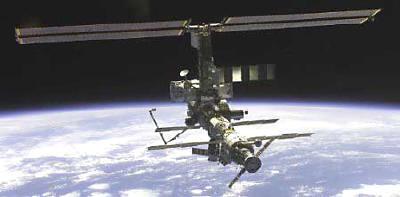Fri, Nov 14, 2003
4 p.m. CST, Friday, Nov. 7, 2003
The Expedition 8 crew
settled into life aboard the International Space Station this week,
squaring away their new home in orbit and beginning work with
several different experiments.
Commander and NASA ISS Science Officer Michael Foale and Flight
Engineer Alexander Kaleri began their week by making room inside
the habitable volume of the Station. After equalizing pressure with
the Destiny Laboratory, they opened Pressurized Mating Adapter 2
(PMA2) and stowed a variety of supplies and equipment that will not
be needed on short notice. They then closed the hatch to PMA2 and
depressurized the module.
Foale slipped on a specially instrumented glove as part of an
Italian scientific investigation into how hand and arm muscles are
used differently for reaching and grasping in microgravity. The
Hand Posture Analyzer also will attempt to quantify muscle fatigue
associated with long-duration space flight. Measurements taken with
a Posture Acquisition Glove on the hand, an Inertial Tracking
System on the wrist and Hand Grip and Pinch Force Dynamometers will
be compared with those taken before and after flight.
Foale and Kaleri also began taking either potassium citrate
pills or placebos and recording their food, water and medication
intake as part of the Renal (Kidney) Stone Risk During Spaceflight
experiment. Previous on-orbit experiments have shown an increased
risk in the development of kidney stones during and immediately
after space flight, and the experiment is testing a proven
Earth-based remedy in space.
Finally, Foale set up the Earth Knowledge Acquired by Middle
Schools digital camera in Destiny's optical-quality window so that
students in grades six through eight could take photos of the Earth
and downlink them for analysis by the student science team.
Meanwhile, Expedition 7 Commander Yuri Malenchenko and NASA ISS
Science Officer Ed Lu are at the Gagarin Cosmonaut Training Center
in Star City, Russia, continuing their immediate post-flight
medical evaluations and debriefings. They are expected to return to
Houston on Nov. 18. They landed on Oct. 27 after spending 183 days
aboard the Station. Joining them on the returning ISS Soyuz 6
spacecraft was European Space Agency astronaut Pedro Duque of
Spain, who conducted eight days of intensive research after
launching with the Expedition 8 crew.

More News
Aero Linx: International Federation of Airworthiness (IFA) We aim to be the most internationally respected independent authority on the subject of Airworthiness. IFA uniquely combi>[...]
Ultrahigh Frequency (UHF) The frequency band between 300 and 3,000 MHz. The bank of radio frequencies used for military air/ground voice communications. In some instances this may >[...]
A Few Questions AND Answers To Help You Get MORE Out of ANN! 1) I forgot my password. How do I find it? 1) Easy... click here and give us your e-mail address--we'll send it to you >[...]
From 2019 (YouTube Edition): Learning To Paint Without Getting Any On Your Hands PPG's Aerospace Coatings Academy is a tool designed to teach everything one needs to know about all>[...]
Also: Sustainable Aircraft Test Put Aside, More Falcon 9 Ops, Wyoming ANG Rescue, Oreo Cookie Into Orbit Joby Aviation has reason to celebrate, recently completing its first full t>[...]
 ANN's Daily Aero-Linx (05.06.25)
ANN's Daily Aero-Linx (05.06.25) ANN's Daily Aero-Term (05.06.25): Ultrahigh Frequency (UHF)
ANN's Daily Aero-Term (05.06.25): Ultrahigh Frequency (UHF) ANN FAQ: Q&A 101
ANN FAQ: Q&A 101 Classic Aero-TV: Virtual Reality Painting--PPG Leverages Technology for Training
Classic Aero-TV: Virtual Reality Painting--PPG Leverages Technology for Training Airborne 05.02.25: Joby Crewed Milestone, Diamond Club, Canadian Pilot Insurance
Airborne 05.02.25: Joby Crewed Milestone, Diamond Club, Canadian Pilot Insurance



